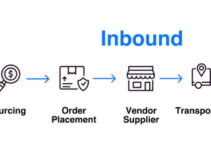Warehouse management plays a key role in the supply chain process and it comprises of shipment of finished goods, receiving raw supplies, and dealing with the order fulfillment process. Improper receiving of raw material would cause misplacement of items in the warehouse, and it would slow down and disrupt the SC process. Today, we’ll discuss WMS supply chain management; its definition, various types, functions and features, and benefits.
What is the WMS Supply Chain?
WMS supply chain management is a software tool that allows businesses and companies to manage and control their various routine warehouse options and functions. The WMS software is the main element of the SCM and provides real-time transparency to the company’s in-transit, in-warehouse, and entire inventory.
However, it provides you with resource utilization, analytics, packing and picking of processes, and much more. It allows you to manage all the warehousing operations from the point when the goods enter the distribution center and the moment they leave
- Receiving material
- Putting away
- Packing and picking
- Shipping processes
- Tracking inventory
- Replenishment
Most importantly, the WMS software has the capability to integrate with other tools and equipment;
- Logistics and ERP software
- Transport Management System
- Advance robotics
- Mission critical solution
- Augmented reality wearable
- RFID labeling
- Bar code scanning
Types of WMS SCM
Some of the main types of WMS supply chain management are as follows;
Integrated SCM and ERP
Some warehouse management system software could easily integrate with SCM and ERP platforms. It would perform better in overlapping areas like business intelligence and accounting. It offers a radical view of logistics and business processes to have end-to-end visibility for warehousing processes.
Cloud WMS
Cloud-based warehouse management system allows you to easily implement it with a limited cost. Software-as-a-service (SaaS) offers you flexibility over the changing market conditions and provides you with seasonal support. However, it provides a quick path to innovation through regular updates, and the service provider updates and maintains the system.
Standalone WMS
A standalone warehouse management system is an on-premise implemented application by employs the company’s hardware. It offers you customization support and the company could easily maintain strict control over the data and software. However, the cost of a standalone warehouse management system cost is much higher than other software and applications.
Functions & Features of WMS SCM
Some of the main features and functions of WMS supply chain management are as follows;
Receiving Supplies
The warehouse management system starts when the company receives, processes, and organizes the raw supplies relevant to the company’s warehousing policies. People used to employ manual processes like pen and paper for physical receipts and procurement orders. According to a research study by Peerless in 2018, 87% of participants said that they were dealing with material and supplies manually during the receiving process.
Managing Inventory
The warehouse management system offers you real-time transparency into the company’s inventory across various locations in-store and in transit. It allows you to track information by employing RFID, barcodes, AIDC technology, and automatic identification. However, the software offers you demand forecasting and cycle counting to the vendor performance by employing advanced analytical tools. It helps you to make adjustments in your inventory level to meet the demands of customers.
Order Packing, Picking, & Fulfillment
According to a study by Logistics Survey Magazine, the most visited place for packing, picking, and fulfillment activities is the warehouse. The order-picking cost contributes approximately 55% of the total warehousing cost. The warehouse management system allows you to decrease their cost by following the efficient method of storing, retrieving, and packing the products.
However, it supports the picking technology that would streamline and smoothen various processes like the following;
- Algorithms
- Robotics
- Pick-to-voice and pick-to-light technology
- Scanning verification
- Radiofrequency
Shipping
Many warehouse management systems could integrate with the logistics and transportation management systems to perform their order fulfillment processes. It performs functions like sending automated shipment notifications, invoices for shipment, and generating packing lists. However, the real-time tracking feature helps them to check whether the package has arrived on time or not.
Managing Labor
The warehouse management system offers real-time insight into productivity gaps, response time, labor cost, trends to plan, and warehouse workers. Along with the key insight, it offers support on various factors like proximity to help the limited workers.
Dock Management
The dock management allows truckers to load their dock quickly. It supports cross-docking, where the product approaches the warehouse; the staff immediately moves them to the outgoing shipment without interim storage, and it is ideal for fresh products.
Benefits of WMS SCM
Some of the main benefits of WMS SCM are as follows;
Improve Relationship
The warehouse management system is beneficial for customers due to limited errors, quick delivery, and better order fulfillment. Resultantly, it amplifies their satisfaction level and reputation of brands, and it would help the company establish better relationships with customers and suppliers.
Better Labor Management
The warehouse management system helps managers predict the needs of customers, develop schedules, improve travel time, and allocate the right tasks to the right employees based on their skills and expertise. A good system would make their employees feel relaxed by making them work in a safe environment.
Inventory Transparency
Various tech equipment like sensors, RFID tagging, and barcoding would help you to track the location of products and vehicles. In fact, it offers you real-time insight into the inventory and how goods move within the inventory.
Low Waste
If the company is dealing with perishable stock like fruits and vegetables, the warehouse management system would help you to recognize the first picking items. Some of the items would require push selling to decrease the waste; it would help you to maximize the usage of space.
Conclusion: WMS Supply Chain
After an in-depth study of WMS supply chain management; we have realized that the warehouse management system is highly significant for efficient inventory management. If you are learning about warehouse management system software, then you should keep in mind the abovementioned definitions, functions, features, types, and benefits.
Ahsan is an accomplished researcher and has a deep insight in worldly life affairs. He goes Live 3 days a week on various social media platforms. Other than research writing, he’s a very interesting person.


